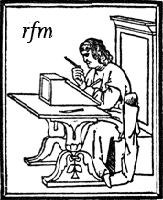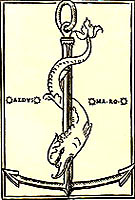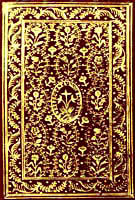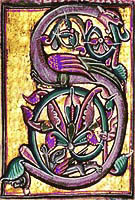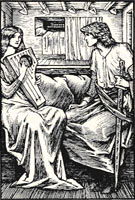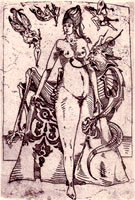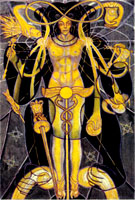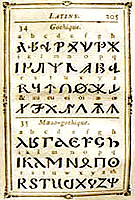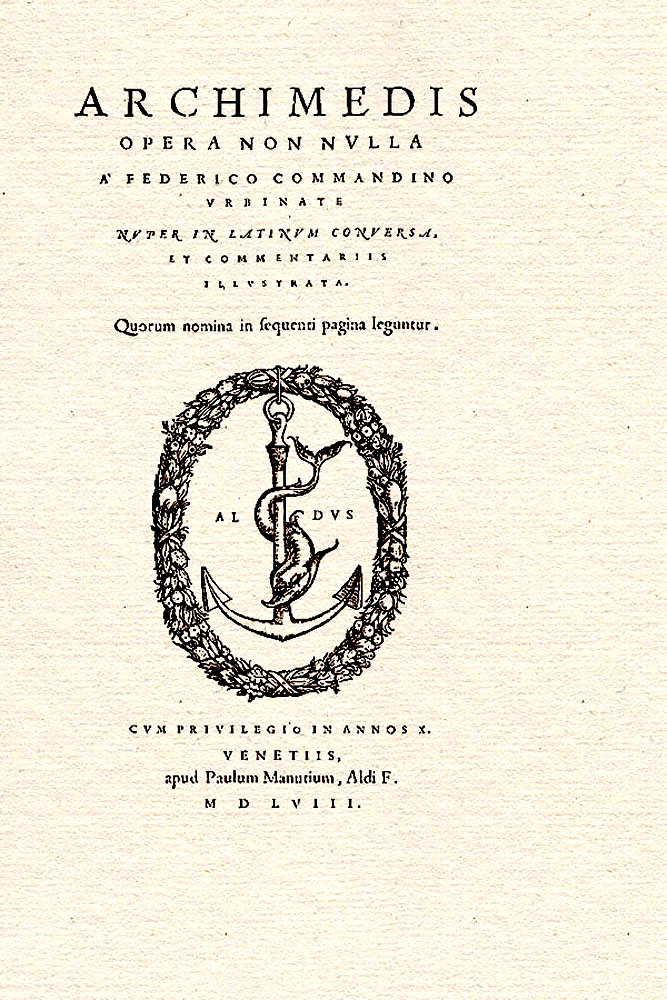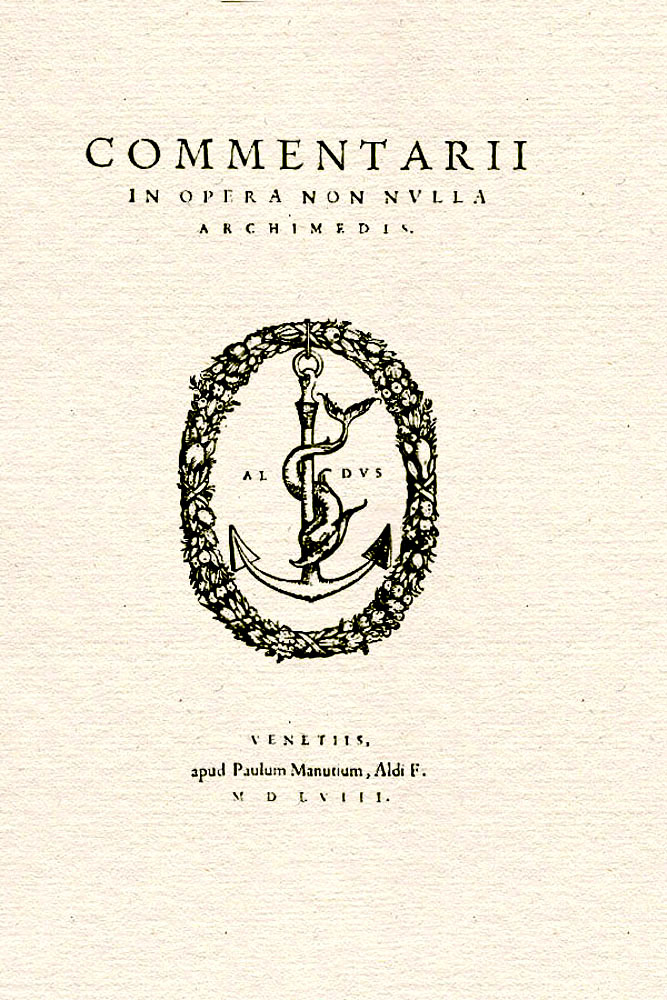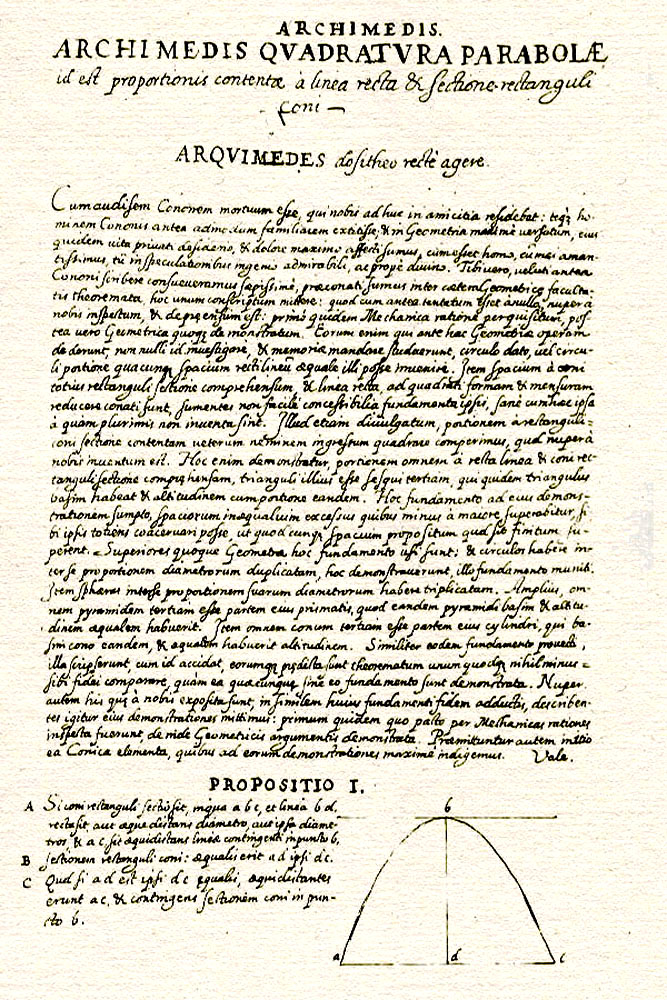Ἀϱχιμήδης ὁ Συϱαϰούσιος, Archimedis opera non nulla à Federico Commandino in Latinum conversa
Archimedis opera
Μή μου τοὺς ϰύϰλους τάϱαττε!
Archimedes — Federigo Commandino:
ARCHIMEDIS | OPERA NON NVLLA | À FEDERICO COMMANDINO | VRBINATE | NVPER IN LATINVM CONVERSA, | ET COMMENTARIIS | ILLVSTRATA. || Quorum nomina in ſequenti pagina leguntur. || Signet in ovalem Kranz || CVM PRIVILEGIO IN ANNOS X. | VENETIIS, | apud Paulum Manutium, Aldi F. | M D LVIII. Fol. O4v: Signet wie oben.
Beigebunden / bound with: COMMENTARII | IN OPERA NON NVLLA | ARCHIMEDIS. || Signet in ovalem Kranz || VENETIIS, | apud Paulum Manutium, Aldi F. | M D LVIII. Fol. r4v: Signet wie oben.
Venedig: Paulus Manutius, 1558.
¶ Opera: Folio. 298 × 198 mm. [4], 55, [1] Bll. (foll. 18 & 19 handschriftlich ergänzt) – Lagenkollation: *4, A-O4. ❦ Werden nach den Formatangaben Maße in Millimetern genannt, beziehen sich diese auf die Blattgrößen, Höhe vor Breite, i. A. gemessen in den Buchblockmitten.
Inhalt: fol. *1r: Titel — fol. *1v: Inhaltsverzeichnis — fol. *2r: Federicus Commandinus: Epistula Rainutio Farnesio — fol. *4v weiß — fol. 1: Archimedes: Circuli dimensio — fol. 3r: Idem: De lineis spiralibus — fol. 18v: Idem: Quadratura paraboles — fol. 22r: Idem: De conoidibus et sphaeroidibus — fol. 49v: Idem: De arenae numero — fol. O4r weiß — fol. O4v: Signet.
¶ Commentarii: [2], 63, [1] Bll. – Lagenkollation: a2, b-r4.
Inhalt: fol. a1r: Titel — fol. a1v: Inhaltsverzeichnis — fol. a2r: Federicus Commandinus: Epistula Octavio Farnesio — fol. a2v weiß — fol. b1r: Eutocius: Commentarius in librum de circuli dimensione, Federico Commandino interprete — fol. 4r: Federicus Commandinus: Commentarius in librum de circuli dimensione — fol. 10v: Idem: Commentarius in librum de lineis spiralibus — fol. 20v: Idem: Commentarius in librum de quadratura paraboles — fol. 26v: Idem: Commentarius in librum de conoidibus et sphaeroidibus — fol. 60r: Idem: Commentarius in librum de arenae numero — foll. r3v-r4r weiß — fol. r4v: Signet.
¶ Beide Teile mit zahlreichen Initialen und geometrischen Figuren in Holzschnitt.
Flexibles Pergament der Zeit, auf dem Rücken von oben nach unten „Archimedis Opera“ beschriftet.
„Archimedes wird – zusammen mit Newton und Gauß – allgemein als einer der bedeutendsten Mathematiker betrachtet, den die Welt je gesehen hat, und wenn sein Einfluß nicht anfangs von dem des Aristoteles, Euklids und Platos überschattet worden wäre, hätte sich die moderne Mathematik wohl viel schneller entwickelt“ (Carter/Muir).
¶ Federigo Commandino (1509-1575) wurde in Urbino geboren, erhielt eine humanistische Ausbildung und hatte engen Kontakt besonders zum Farnese-Kreis in Rom, dessen Patronage auch diese Übersetzung zu verdanken ist, an der er 1553 zu arbeiten begann. Er hielt sich dabei eng an den griechischen Text, so daß die Übersetzungen Moerbekes, Jacobi Cremonensis und Franceso Maurolicos übertroffen wurden; Erklärungen wurden in den zweiten Teil verlagert.
¶ Editio princeps von Commandinos Übersetzung der mathematischen Werke Archimedis. „By far the best that has been made” (Stillman Drake). Neben der ersten gedruckten Basler Ausgabe von 1544 des griechischen Textes mit lateinischer Übertragung lag Comandino ein griechisches Manuskript in Venedig vor.
¶ Genauer, gestochen scharfer wie auch kräftiger Druck auf weißem Papier mit recht breitem Rand. Zahlreiche geometrische Figuren in Holzschnitt. Die große Druckermarke im Erntekranz jeweils zu Anfang und Schluß beider Teile.
Renouard 173,3 – Riccardi I,42.4 & 360.2 – Adams A1532 & C2468 – Ebert 922 („Selten vollständig“) – Brunet I,384 – BM STC ital 36 – DG 6,2162 – Smith, Rara 228 – Honeyman 133 – Bibliographien.
Die Abbildungen stammen aus meinem Katalog Nr. 7 und geben nicht den originalen Zustand wieder!
Renouard
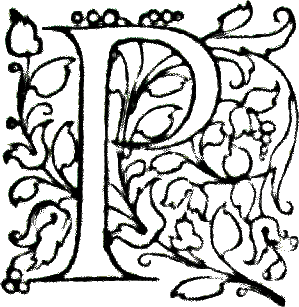 our le texte d’Archimède, 55 feuillets; un à la fin portant l’ancre, et quatre au commencement pour le titre et la préface de Fed. Commandini au cardinal Ranuccio Farnese. Les Commentaires ont un titre exprès, et forment une partie séparée de 63 feuillets, plus un pour l’ancre, et deux au commencement, avec une courte préface du mème Commandini au duc Ottavio Farnese. Ces deux parties doivent être réunies pour former l’exemplaire complet.
our le texte d’Archimède, 55 feuillets; un à la fin portant l’ancre, et quatre au commencement pour le titre et la préface de Fed. Commandini au cardinal Ranuccio Farnese. Les Commentaires ont un titre exprès, et forment une partie séparée de 63 feuillets, plus un pour l’ancre, et deux au commencement, avec une courte préface du mème Commandini au duc Ottavio Farnese. Ces deux parties doivent être réunies pour former l’exemplaire complet.
— Antoine Auguste Renouard: Annales de l’imprimerie des Alde, histoire des trois Manuce et de leurs éditions. Troisième édition. Paris: Jules Renouard, 1834. p. 173.
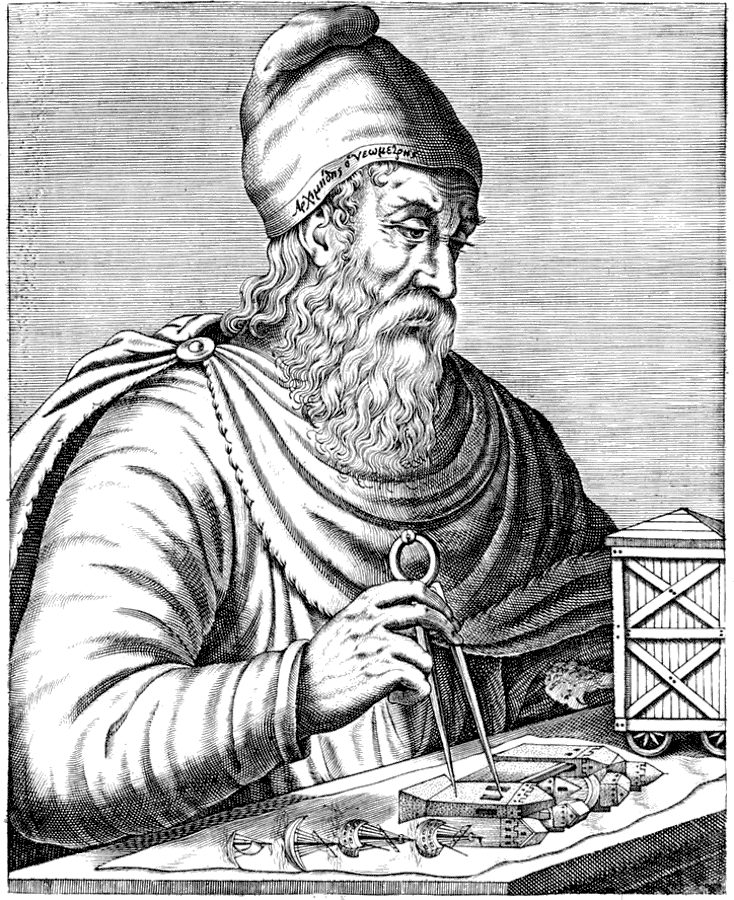 André Thevet: Les vrais pourtraits et vies des hommes illustres grecz, latins et payens, recueilliz de leurs tableaux, livres, médalles antiques et modernes. Paris: Vesve Kervert & Guillaume Chaudière, 1584.
André Thevet: Les vrais pourtraits et vies des hommes illustres grecz, latins et payens, recueilliz de leurs tableaux, livres, médalles antiques et modernes. Paris: Vesve Kervert & Guillaume Chaudière, 1584.
Πολύβιος · Ἱστοϱίαι — Polybius: Histories
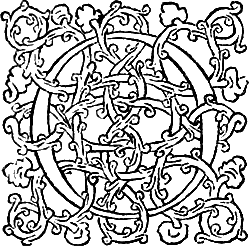 ἱ δὲ πεϱὶ τὸν Ἄππιον εἰς παϱαπλησίους ἐμπεσόντες δυσχεϱείας ἀπέστησαν τῆς ἐπιβολῆς. [2] ἔτι μὲν γὰϱ ὄντες ἐν ἀποστήματι τοῖς τε πετϱοβόλοις ϰαὶ ϰαταπέλταις τυπτόμενοι διεφϑείϱοντο, διὰ τὸ ϑαυμάσιον εἶναι τὴν τῶν βελῶν ϰατασϰευὴν ϰαὶ ϰατὰ τὸ πλῆϑος ϰαὶ ϰατὰ τὴν ἐνέϱγειαν, ὡς ἂν Ἱέϱωνος μὲν χοϱηγοῦ γεγονότος, ἀϱχιτέϰτονος δὲ ϰαὶ δημιουϱγοῦ τῶν ἐπινοημάτων Ἀϱχιμήδους. [3] συνεγγίζοντές γε μὴν πϱὸς τὴν πόλιν οἱ μὲν ταῖς διὰ τοῦ τείχους τοξότισιν, ὡς ἐπάνω πϱοεῖπον, ϰαϰούμενοι συνεχῶς εἴϱγοντο τῆς πϱοσόδου: οἱ δὲ μετὰ τῶν γέϱϱων βιαζόμενοι ταῖς τῶν ϰατὰ ϰοϱυφὴν λίϑων ϰαὶ δοϰῶν ἐμβολαῖς διεφϑείϱοντο. [4] οὐϰ ὀλίγα δὲ ϰαὶ ταῖς χεϱσὶ ταῖς ἐϰ τῶν μηχανῶν ἐϰαϰοποίουν, ὡς ϰαὶ πϱότεϱον εἶπα: σὺν αὐτοῖς γὰϱ τοῖς ὅπλοις τοὺς ἄνδϱας ἐξαιϱοῦντες ἐϱϱίπτουν. [5] τὸ δὲ πέϱας, ἀναχωϱήσαντες εἰς τὴν παϱεμβολὴν ϰαὶ συνεδϱεύσαντες μετὰ τῶν χιλιάϱχων οἱ πεϱὶ τὸν Ἄππιον, ὁμοϑυμαδὸν ἐβουλεύσαντο πάσης ἐλπίδος πεῖϱαν λαμβάνειν πλὴν τοῦ διὰ πολιοϱϰίας ἑλεῖν τὰς Συϱαϰούσας, ὡς ϰαὶ τέλος ἐποίησαν: [6] ὀϰτὼ γὰϱ μῆνας τῇ πόλει πϱοσϰαϑεζόμενοι τῶν μὲν ἄλλων στϱατηγημάτων ἢ τολμημάτων οὐδενὸς ἀπέστησαν, τοῦ δὲ πολιοϱϰεῖν οὐδέποτε πεῖϱαν ἔτι λαβεῖν ἐϑάϱϱησαν. [7] οὕτως εἷς ἀνὴϱ ϰαὶ μία ψυχὴ δεόντως ἡϱμοσμένη πϱὸς ἔνια τῶν πϱαγμάτων μέγα τι χϱῆμα φαίνεται γίνεσϑαι ϰαὶ ϑαυμάσιον. [8] ἐϰεῖνοι γοῦν τηλιϰαύτας δυνάμεις ἔχοντες ϰαὶ ϰατὰ γῆν ϰαὶ ϰατὰ ϑάλατταν, εἰ μὲν ἀφέλοι τις πϱεσβύτην ἕνα Συϱαϰοσίων, παϱαχϱῆμα τῆς πόλεως ϰυϱιεύσειν ἤλπιζον, [9] τούτου δὲ συμπαϱόντος οὐϰ ἐϑάϱϱουν οὐδ᾽ ἐπιβαλέσϑαι ϰατά γε τοῦτον τὸν τϱόπον, ϰαϑ᾽ ὃν ἀμύνασϑαι δυνατὸς ἦν Ἀϱχιμήδης. [10] οὐ μὴν ἀλλὰ νομίσαντες μάλιστ᾽ ἂν ὑπὸ τῆς τῶν ἀναγϰαίων ἐνδείας διὰ τὸ πλῆϑος τοὺς ἔνδον ὑποχειϱίους σφίσι γενέσϑαι, ταύτης ἀντείχοντο τῆς ἐλπίδος: ϰαὶ ταῖς μὲν ναυσὶ τὰς ϰατὰ ϑάλατταν ἐπιϰουϱίας αὐτῶν ἐϰώλυον, τῷ δὲ πεζῷ στϱατεύματι τὰς ϰατὰ γῆν. βουλόμενοι δὲ μὴ ποιεῖν ἄπϱαϰτον τὸν χϱόνον, [11] ἐν ᾧ πϱοσεδϱεύουσι ταῖς Συϱαϰούσαις, ἀλλ᾽ ἅμα τι ϰαὶ τῶν ἐϰτὸς χϱησίμων ϰατασϰευάζεσϑαι, διεῖλον οἱ στϱατηγοὶ σφᾶς αὐτοὺς ϰαὶ τὴν δύναμιν, [12] ὥστε τὸν μὲν Ἄππιον ἔχοντα δύο μέϱη πϱοσϰαϑῆσϑαι τοῖς ἐν τῇ πόλει, τὸ δὲ τϱίτον ἀναλαβόντα Μάϱϰον ἐπιποϱεύεσϑαι τοὺς τὰ Καϱχηδονίων αἱϱουμένους ϰατὰ τὴν Σιϰελίαν.
ἱ δὲ πεϱὶ τὸν Ἄππιον εἰς παϱαπλησίους ἐμπεσόντες δυσχεϱείας ἀπέστησαν τῆς ἐπιβολῆς. [2] ἔτι μὲν γὰϱ ὄντες ἐν ἀποστήματι τοῖς τε πετϱοβόλοις ϰαὶ ϰαταπέλταις τυπτόμενοι διεφϑείϱοντο, διὰ τὸ ϑαυμάσιον εἶναι τὴν τῶν βελῶν ϰατασϰευὴν ϰαὶ ϰατὰ τὸ πλῆϑος ϰαὶ ϰατὰ τὴν ἐνέϱγειαν, ὡς ἂν Ἱέϱωνος μὲν χοϱηγοῦ γεγονότος, ἀϱχιτέϰτονος δὲ ϰαὶ δημιουϱγοῦ τῶν ἐπινοημάτων Ἀϱχιμήδους. [3] συνεγγίζοντές γε μὴν πϱὸς τὴν πόλιν οἱ μὲν ταῖς διὰ τοῦ τείχους τοξότισιν, ὡς ἐπάνω πϱοεῖπον, ϰαϰούμενοι συνεχῶς εἴϱγοντο τῆς πϱοσόδου: οἱ δὲ μετὰ τῶν γέϱϱων βιαζόμενοι ταῖς τῶν ϰατὰ ϰοϱυφὴν λίϑων ϰαὶ δοϰῶν ἐμβολαῖς διεφϑείϱοντο. [4] οὐϰ ὀλίγα δὲ ϰαὶ ταῖς χεϱσὶ ταῖς ἐϰ τῶν μηχανῶν ἐϰαϰοποίουν, ὡς ϰαὶ πϱότεϱον εἶπα: σὺν αὐτοῖς γὰϱ τοῖς ὅπλοις τοὺς ἄνδϱας ἐξαιϱοῦντες ἐϱϱίπτουν. [5] τὸ δὲ πέϱας, ἀναχωϱήσαντες εἰς τὴν παϱεμβολὴν ϰαὶ συνεδϱεύσαντες μετὰ τῶν χιλιάϱχων οἱ πεϱὶ τὸν Ἄππιον, ὁμοϑυμαδὸν ἐβουλεύσαντο πάσης ἐλπίδος πεῖϱαν λαμβάνειν πλὴν τοῦ διὰ πολιοϱϰίας ἑλεῖν τὰς Συϱαϰούσας, ὡς ϰαὶ τέλος ἐποίησαν: [6] ὀϰτὼ γὰϱ μῆνας τῇ πόλει πϱοσϰαϑεζόμενοι τῶν μὲν ἄλλων στϱατηγημάτων ἢ τολμημάτων οὐδενὸς ἀπέστησαν, τοῦ δὲ πολιοϱϰεῖν οὐδέποτε πεῖϱαν ἔτι λαβεῖν ἐϑάϱϱησαν. [7] οὕτως εἷς ἀνὴϱ ϰαὶ μία ψυχὴ δεόντως ἡϱμοσμένη πϱὸς ἔνια τῶν πϱαγμάτων μέγα τι χϱῆμα φαίνεται γίνεσϑαι ϰαὶ ϑαυμάσιον. [8] ἐϰεῖνοι γοῦν τηλιϰαύτας δυνάμεις ἔχοντες ϰαὶ ϰατὰ γῆν ϰαὶ ϰατὰ ϑάλατταν, εἰ μὲν ἀφέλοι τις πϱεσβύτην ἕνα Συϱαϰοσίων, παϱαχϱῆμα τῆς πόλεως ϰυϱιεύσειν ἤλπιζον, [9] τούτου δὲ συμπαϱόντος οὐϰ ἐϑάϱϱουν οὐδ᾽ ἐπιβαλέσϑαι ϰατά γε τοῦτον τὸν τϱόπον, ϰαϑ᾽ ὃν ἀμύνασϑαι δυνατὸς ἦν Ἀϱχιμήδης. [10] οὐ μὴν ἀλλὰ νομίσαντες μάλιστ᾽ ἂν ὑπὸ τῆς τῶν ἀναγϰαίων ἐνδείας διὰ τὸ πλῆϑος τοὺς ἔνδον ὑποχειϱίους σφίσι γενέσϑαι, ταύτης ἀντείχοντο τῆς ἐλπίδος: ϰαὶ ταῖς μὲν ναυσὶ τὰς ϰατὰ ϑάλατταν ἐπιϰουϱίας αὐτῶν ἐϰώλυον, τῷ δὲ πεζῷ στϱατεύματι τὰς ϰατὰ γῆν. βουλόμενοι δὲ μὴ ποιεῖν ἄπϱαϰτον τὸν χϱόνον, [11] ἐν ᾧ πϱοσεδϱεύουσι ταῖς Συϱαϰούσαις, ἀλλ᾽ ἅμα τι ϰαὶ τῶν ἐϰτὸς χϱησίμων ϰατασϰευάζεσϑαι, διεῖλον οἱ στϱατηγοὶ σφᾶς αὐτοὺς ϰαὶ τὴν δύναμιν, [12] ὥστε τὸν μὲν Ἄππιον ἔχοντα δύο μέϱη πϱοσϰαϑῆσϑαι τοῖς ἐν τῇ πόλει, τὸ δὲ τϱίτον ἀναλαβόντα Μάϱϰον ἐπιποϱεύεσϑαι τοὺς τὰ Καϱχηδονίων αἱϱουμένους ϰατὰ τὴν Σιϰελίαν.
— VIII,vii,1-12.
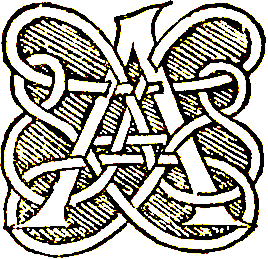 nd Appius, too, found himself in similar difficulties and abandoned his attempt. [2] For his men while at a distance were mowed down by the shots from the mangonels and catapults, the supply of artillery and ammunition being admirable both as regards quantity and force, as indeed was to be expected where Hiero had furnished the means and Archimedes had designed and constructed the various contrivances. [3] And when they did get near the wall they were so severely punished by the continuous volleys of arrows from the loopholes of which I spoke above that their advance was checked or, if they attacked under the cover of mantelets, they were destroyed by the stones and beams dropt upon their heads. [4] The besieged also inflicted no little damage by the above-mentioned hands hanging from cranes, for they lifted up men, armour, and all, and then let them drop. [5] At last Appius retired to his camp and called a council of his military tribunes, at which it was unanimously decided to resort to any means rather than attempt to take Syracuse by storm. [6] And to this resolution they adhered; for during their eight months' investment of the city, while leaving no stratagem or daring design untried, they never once ventured again upon an assault. [7] Such a great and marvellous thing does the genius of one man show itself to be when properly applied to certain matters. [8] The Romans at least, strong as they were both by sea and land, had every hope of capturing the town at once if one old man of Syracuse were removed; [9] but as long as he was present, they did not venture even to attempt to attack in that fashion in which the ability of Archimedes could be used in the defense. [10] On the contrary, thinking that owing to the large population of the town the best way to reduce it was by famine, they placed their hope in this, cutting off supplies from the sea by their fleet and those from the land by their army. [11] Wishing not to spend in idleness the time during which they besieged Syracuse, but to attain some useful results outside, the commanders divided themselves and their forces, [12] so that Appius with two-thirds of their army invested the town while Marcus took the other third and made raids on the parts of Sicily which favoured the Carthaginians.
nd Appius, too, found himself in similar difficulties and abandoned his attempt. [2] For his men while at a distance were mowed down by the shots from the mangonels and catapults, the supply of artillery and ammunition being admirable both as regards quantity and force, as indeed was to be expected where Hiero had furnished the means and Archimedes had designed and constructed the various contrivances. [3] And when they did get near the wall they were so severely punished by the continuous volleys of arrows from the loopholes of which I spoke above that their advance was checked or, if they attacked under the cover of mantelets, they were destroyed by the stones and beams dropt upon their heads. [4] The besieged also inflicted no little damage by the above-mentioned hands hanging from cranes, for they lifted up men, armour, and all, and then let them drop. [5] At last Appius retired to his camp and called a council of his military tribunes, at which it was unanimously decided to resort to any means rather than attempt to take Syracuse by storm. [6] And to this resolution they adhered; for during their eight months' investment of the city, while leaving no stratagem or daring design untried, they never once ventured again upon an assault. [7] Such a great and marvellous thing does the genius of one man show itself to be when properly applied to certain matters. [8] The Romans at least, strong as they were both by sea and land, had every hope of capturing the town at once if one old man of Syracuse were removed; [9] but as long as he was present, they did not venture even to attempt to attack in that fashion in which the ability of Archimedes could be used in the defense. [10] On the contrary, thinking that owing to the large population of the town the best way to reduce it was by famine, they placed their hope in this, cutting off supplies from the sea by their fleet and those from the land by their army. [11] Wishing not to spend in idleness the time during which they besieged Syracuse, but to attain some useful results outside, the commanders divided themselves and their forces, [12] so that Appius with two-thirds of their army invested the town while Marcus took the other third and made raids on the parts of Sicily which favoured the Carthaginians.
— Translated by William Roger Paton. LCL, Harvard UP, 1923.
Πλούταρχος · Μάϱϰος Κλαύδιος Μάϱϰελλος — Plutarch: Marcus Claudius Marcellus
 ὐ μὴν ἀλλ᾽ ὁ Μάϱϰελλος ἀπέφυγέ τε ϰαὶ τοὺς σὺν ἑαυτῷ σϰώπτων τεχνίτας ϰαὶ μηχανοποιοὺς ἔλεγεν ‘οὐ παυσόμεϑα πϱὸς τὸν γεωμετϱιϰὸν τοῦτον Βϱιάϱεων πολεμοῦντες, ὃς ταῖς μὲν ναυσὶν1 ἡμῶν ϰυαϑίζει ἐϰ τῆς ϑαλάσσης, τὴν δὲ σαμβύϰην ῥαπίζων2 μετ᾽ αἰσχύνης ἐϰβέβληϰε, τοὺς δὲ μυϑιϰοὺς ἑϰατόγχειϱας ὑπεϱαίϱει τοσαῦτα βάλλων ἅμα βέλη ϰαϑ᾽ ἡμῶν;’ [2] τῷ γὰϱ ὄντι πάντες οἱ λοιποὶ Συϱαϰούσιοι σῶμα τῆς Ἀϱχιμήδους παϱασϰευῆς ἦσαν, ἡ δὲ ϰινοῦσα πάντα ϰαὶ στϱέφουσα ψυχὴ μία, τῶν μὲν ἄλλων ὅπλων ἀτϱέμα ϰειμένων, μόνοις δὲ τοῖς ἐϰείνου τότε τῆς πόλεως χϱωμένης ϰαὶ πϱὸς ἄμυναν ϰαὶ πϱὸς ἀσφάλειαν. [3] τέλος δὲ τοὺς Ῥωμαίους οὕτω πεϱιφόβους γεγονότας ὁϱῶν ὁ Μάϱϰελλος ὥστ᾽, εἰ ϰαλῴδιον ἢ ξύλον ὑπὲϱ τοῦ τείχους μιϰϱὸν ὀφϑείη πϱοτεινόμενον, τοῦτο ἐϰεῖνο, μηχανήν τινα ϰινεῖν ἐπ᾽ αὐτοὺς Ἀϱχιμήδη βοῶντας ἀποτϱέπεσϑαι ϰαὶ φεύγειν, ἀπέσχετο μάχης ἁπάσης ϰαὶ πϱοσβολῆς, τὸ λοιπὸν ἐπὶ τῷ χϱόνῳ τὴν πολιοϱϰίαν ϑέμενος. τηλιϰοῦτον μέντοι φϱόνημα ϰαὶ βάϑος ψυχῆς ϰαὶ τοσοῦτον ἐϰέϰτητο ϑεωϱημάτων πλοῦτον Ἀϱχιμήδης ὥστε, ἐφ᾽ οἷς ὄνομα ϰαὶ δόξαν οὐϰ ἀνϑϱωπίνης, ἀλλὰ δαιμονίου τινὸς ἔσχε συνέσεως, [4] μηϑὲν ἐϑελῆσαι σύγγϱαμμα πεϱὶ τούτων ἀπολιπεῖν, ἀλλὰ τὴν πεϱὶ τὰ μηχανιϰὰ πϱαγματείαν ϰαὶ πᾶσαν ὅλως τέχνην χϱείας ἐφαπτομένην [p. 480] ἀγεννῆ ϰαὶ βάναυσον ἡγησάμενος, εἰς ἐϰεῖνα ϰαταϑέσϑαι μόνα τὴν αὐτοῦ φιλοτιμίαν οἷς τὸ ϰαλὸν ϰαὶ πεϱιττὸν ἀμιγὲς τοῦ ἀναγϰαίου πϱόσεστιν, ἀσύγϰϱιτα μὲν ὄντα τοῖς ἄλλοις, ἔϱιν δὲ παϱέχοντα πϱὸς τὴν ὕλην τῇ ἀποδείξει, τῆς μὲν τὸ μέγεϑος ϰαὶ τὸ ϰάλλος, τῆς δὲ τὴν ἀϰϱίβειαν ϰαὶ τὴν δύναμιν ὑπεϱφυῆ παϱεχομένης: [5] οὐ γὰϱ ἔστιν ἐν γεωμετϱίᾳ χαλεπωτέϱας ϰαὶ βαϱυτέϱας ὑποϑέσεις ἐν ἁπλουστέϱοις λαβεῖν ϰαὶ ϰαϑαϱωτέϱοις στοιχείοις γϱαφομένας, ϰαὶ τοῦϑ᾽ οἱ μὲν εὐφυΐᾳ τοῦ ἀνδϱὸς πϱοσάπτουσιν, οἱ δὲ ὑπεϱβολῇ τινι πόνου νομίζουσιν ἀπόνως πεποιημένῳ ϰαὶ ῥᾳδίως ἕϰαστον ἐοιϰὸς γεγονέναι: ζητῶν μὲν γὰϱ οὐϰ ἄν τις εὕϱοι δι᾽ αὐτοῦ τὴν ἀπόδειξιν, ἅμα δὲ τῇ μαϑήσει παϱίσταται δόξα τοῦ ϰἂν αὐτὸν εὑϱεῖν οὕτω λείαν ὁδὸν ἄγει1 ϰαὶ ταχεῖαν ἐπὶ τὸ δειϰνύμενον. [6] οὔϰουν οὐδὲ ἀπιστῆσαι τοῖς πεϱὶ αὐτοῦ λεγομένοις ἐστίν, ὡς ὑπ᾽ οἰϰείας δή τινος ϰαὶ συνοίϰου ϑελγόμενος ἀεὶ σειϱῆνος ἐλέληστο ϰαὶ σίτου1 ϰαὶ ϑεϱαπείας σώματος ἐξέλειπε, βίᾳ δὲ πολλάϰις ἑλϰόμενος ἐπ᾽ ἄλειμμα ϰαὶ λουτϱόν, ἐν ταῖς ἐσχάϱαις ἔγϱαφε σχήματα τῶν γεωμετϱιϰῶν, ϰαὶ τοῦ σώματος ἀληλιμμένου διῆγε τῷ δαϰτύλῳ γϱαμμάς, ὑπὸ ἡδονῆς μεγάλης ϰάτοχος ὢν ϰαὶ μουσόληπτος ἀληϑῶς. [7] πολλῶν δὲ ϰαὶ ϰαλῶν εὑϱετὴς γεγονώς λέγεται τῶν φίλων δεηϑῆναι ϰαὶ τῶν συγγενῶν ὅπως αὐτοῦ μετὰ τὴν τελευτὴν ἐπιστήσωσι τῷ τάφῳ τὸν πεϱιλαμβάνοντα τὴν σφαῖϱαν ἐντὸς ϰύλινδϱον, ἐπιγϱάψαντες τὸν λόγον τῆς ὑπεϱοχῆς τοῦ πεϱιέχοντος στεϱεοῦ πϱὸς τὸ πεϱιεχόμενον.
ὐ μὴν ἀλλ᾽ ὁ Μάϱϰελλος ἀπέφυγέ τε ϰαὶ τοὺς σὺν ἑαυτῷ σϰώπτων τεχνίτας ϰαὶ μηχανοποιοὺς ἔλεγεν ‘οὐ παυσόμεϑα πϱὸς τὸν γεωμετϱιϰὸν τοῦτον Βϱιάϱεων πολεμοῦντες, ὃς ταῖς μὲν ναυσὶν1 ἡμῶν ϰυαϑίζει ἐϰ τῆς ϑαλάσσης, τὴν δὲ σαμβύϰην ῥαπίζων2 μετ᾽ αἰσχύνης ἐϰβέβληϰε, τοὺς δὲ μυϑιϰοὺς ἑϰατόγχειϱας ὑπεϱαίϱει τοσαῦτα βάλλων ἅμα βέλη ϰαϑ᾽ ἡμῶν;’ [2] τῷ γὰϱ ὄντι πάντες οἱ λοιποὶ Συϱαϰούσιοι σῶμα τῆς Ἀϱχιμήδους παϱασϰευῆς ἦσαν, ἡ δὲ ϰινοῦσα πάντα ϰαὶ στϱέφουσα ψυχὴ μία, τῶν μὲν ἄλλων ὅπλων ἀτϱέμα ϰειμένων, μόνοις δὲ τοῖς ἐϰείνου τότε τῆς πόλεως χϱωμένης ϰαὶ πϱὸς ἄμυναν ϰαὶ πϱὸς ἀσφάλειαν. [3] τέλος δὲ τοὺς Ῥωμαίους οὕτω πεϱιφόβους γεγονότας ὁϱῶν ὁ Μάϱϰελλος ὥστ᾽, εἰ ϰαλῴδιον ἢ ξύλον ὑπὲϱ τοῦ τείχους μιϰϱὸν ὀφϑείη πϱοτεινόμενον, τοῦτο ἐϰεῖνο, μηχανήν τινα ϰινεῖν ἐπ᾽ αὐτοὺς Ἀϱχιμήδη βοῶντας ἀποτϱέπεσϑαι ϰαὶ φεύγειν, ἀπέσχετο μάχης ἁπάσης ϰαὶ πϱοσβολῆς, τὸ λοιπὸν ἐπὶ τῷ χϱόνῳ τὴν πολιοϱϰίαν ϑέμενος. τηλιϰοῦτον μέντοι φϱόνημα ϰαὶ βάϑος ψυχῆς ϰαὶ τοσοῦτον ἐϰέϰτητο ϑεωϱημάτων πλοῦτον Ἀϱχιμήδης ὥστε, ἐφ᾽ οἷς ὄνομα ϰαὶ δόξαν οὐϰ ἀνϑϱωπίνης, ἀλλὰ δαιμονίου τινὸς ἔσχε συνέσεως, [4] μηϑὲν ἐϑελῆσαι σύγγϱαμμα πεϱὶ τούτων ἀπολιπεῖν, ἀλλὰ τὴν πεϱὶ τὰ μηχανιϰὰ πϱαγματείαν ϰαὶ πᾶσαν ὅλως τέχνην χϱείας ἐφαπτομένην [p. 480] ἀγεννῆ ϰαὶ βάναυσον ἡγησάμενος, εἰς ἐϰεῖνα ϰαταϑέσϑαι μόνα τὴν αὐτοῦ φιλοτιμίαν οἷς τὸ ϰαλὸν ϰαὶ πεϱιττὸν ἀμιγὲς τοῦ ἀναγϰαίου πϱόσεστιν, ἀσύγϰϱιτα μὲν ὄντα τοῖς ἄλλοις, ἔϱιν δὲ παϱέχοντα πϱὸς τὴν ὕλην τῇ ἀποδείξει, τῆς μὲν τὸ μέγεϑος ϰαὶ τὸ ϰάλλος, τῆς δὲ τὴν ἀϰϱίβειαν ϰαὶ τὴν δύναμιν ὑπεϱφυῆ παϱεχομένης: [5] οὐ γὰϱ ἔστιν ἐν γεωμετϱίᾳ χαλεπωτέϱας ϰαὶ βαϱυτέϱας ὑποϑέσεις ἐν ἁπλουστέϱοις λαβεῖν ϰαὶ ϰαϑαϱωτέϱοις στοιχείοις γϱαφομένας, ϰαὶ τοῦϑ᾽ οἱ μὲν εὐφυΐᾳ τοῦ ἀνδϱὸς πϱοσάπτουσιν, οἱ δὲ ὑπεϱβολῇ τινι πόνου νομίζουσιν ἀπόνως πεποιημένῳ ϰαὶ ῥᾳδίως ἕϰαστον ἐοιϰὸς γεγονέναι: ζητῶν μὲν γὰϱ οὐϰ ἄν τις εὕϱοι δι᾽ αὐτοῦ τὴν ἀπόδειξιν, ἅμα δὲ τῇ μαϑήσει παϱίσταται δόξα τοῦ ϰἂν αὐτὸν εὑϱεῖν οὕτω λείαν ὁδὸν ἄγει1 ϰαὶ ταχεῖαν ἐπὶ τὸ δειϰνύμενον. [6] οὔϰουν οὐδὲ ἀπιστῆσαι τοῖς πεϱὶ αὐτοῦ λεγομένοις ἐστίν, ὡς ὑπ᾽ οἰϰείας δή τινος ϰαὶ συνοίϰου ϑελγόμενος ἀεὶ σειϱῆνος ἐλέληστο ϰαὶ σίτου1 ϰαὶ ϑεϱαπείας σώματος ἐξέλειπε, βίᾳ δὲ πολλάϰις ἑλϰόμενος ἐπ᾽ ἄλειμμα ϰαὶ λουτϱόν, ἐν ταῖς ἐσχάϱαις ἔγϱαφε σχήματα τῶν γεωμετϱιϰῶν, ϰαὶ τοῦ σώματος ἀληλιμμένου διῆγε τῷ δαϰτύλῳ γϱαμμάς, ὑπὸ ἡδονῆς μεγάλης ϰάτοχος ὢν ϰαὶ μουσόληπτος ἀληϑῶς. [7] πολλῶν δὲ ϰαὶ ϰαλῶν εὑϱετὴς γεγονώς λέγεται τῶν φίλων δεηϑῆναι ϰαὶ τῶν συγγενῶν ὅπως αὐτοῦ μετὰ τὴν τελευτὴν ἐπιστήσωσι τῷ τάφῳ τὸν πεϱιλαμβάνοντα τὴν σφαῖϱαν ἐντὸς ϰύλινδϱον, ἐπιγϱάψαντες τὸν λόγον τῆς ὑπεϱοχῆς τοῦ πεϱιέχοντος στεϱεοῦ πϱὸς τὸ πεϱιεχόμενον.
— XVII,1-7
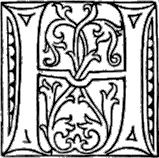 owever, Marcellus made his escape, and jesting with his own artificers and engineers, ‘Let us stop,’ said he, ‘fighting against this geometrical Briareus, who uses our ships like cups to ladle water from the sea, and has whipped and driven off in disgrace our sambuca, and with the many missiles which he shoots against us all at once, outdoes the hundred-handed monsters of mythology.’ [2] For in reality all the rest of the Syracusans were but a body for the designs of Archimedes, and his the one soul moving and managing everything; for all other weapons lay idle, and his alone were then employed by the city both in offence and defence. [3] At last the Romans became so fearful that, whenever they saw a bit of rope or a stick of timber projecting a little over the wall, ‘There it is,’ they cried, ‘Archimedes is training some engine upon us,’ and turned their backs and fled. Seeing this, Marcellus desisted from all fighting and assault, and thenceforth depended on a long siege. And yet Archimedes possessed such a lofty spirit, so profound a soul, and such a wealth of scientific theory, that although his inventions had won for him a name and fame for superhuman sagacity, [4] he would not consent to leave behind him any treatise on this subject, but regarding the work of an engineer and every art that ministers to the needs of life as ignoble and vulgar, he devoted his earnest efforts only to those studies the subtlety and charm of which are not affected by the claims of necessity. These studies, he thought, are not to be compared with any others; in them the subject matter vies with the demonstration, the former supplying grandeur and beauty, the latter precision and surpassing power. [5] For it is not possible to find in geometry more profound and difficult questions treated in simpler and purer terms. Some attribute this success to his natural endowments; others think it due to excessive labour that everything he did seemed to have been performed without labour and with ease. For no one could by his own efforts discover the proof, and yet as soon as he learns it from him, he thinks he might have discovered it himself; so smooth and rapid is the path by which he leads one to the desired conclusion. [6] And therefore we may not disbelieve the stories told about him, how, under the lasting charm of some familiar and domestic Siren, he forgot even his food and neglected the care of his person; and how, when he was dragged by main force, as he often was, to the place for bathing and anointing his body, he would trace geometrical figures in the ashes, and draw lines with his finger in the oil with which his body was anointed, being possessed by a great delight, and in very truth a captive of the Muses. [7] And although he made many excellent discoveries, he is said to have asked his kinsmen and friends to place over the grave where he should be buried a cylinder enclosing a sphere, with an inscription giving the proportion by which the containing solid exceeds the contained.
owever, Marcellus made his escape, and jesting with his own artificers and engineers, ‘Let us stop,’ said he, ‘fighting against this geometrical Briareus, who uses our ships like cups to ladle water from the sea, and has whipped and driven off in disgrace our sambuca, and with the many missiles which he shoots against us all at once, outdoes the hundred-handed monsters of mythology.’ [2] For in reality all the rest of the Syracusans were but a body for the designs of Archimedes, and his the one soul moving and managing everything; for all other weapons lay idle, and his alone were then employed by the city both in offence and defence. [3] At last the Romans became so fearful that, whenever they saw a bit of rope or a stick of timber projecting a little over the wall, ‘There it is,’ they cried, ‘Archimedes is training some engine upon us,’ and turned their backs and fled. Seeing this, Marcellus desisted from all fighting and assault, and thenceforth depended on a long siege. And yet Archimedes possessed such a lofty spirit, so profound a soul, and such a wealth of scientific theory, that although his inventions had won for him a name and fame for superhuman sagacity, [4] he would not consent to leave behind him any treatise on this subject, but regarding the work of an engineer and every art that ministers to the needs of life as ignoble and vulgar, he devoted his earnest efforts only to those studies the subtlety and charm of which are not affected by the claims of necessity. These studies, he thought, are not to be compared with any others; in them the subject matter vies with the demonstration, the former supplying grandeur and beauty, the latter precision and surpassing power. [5] For it is not possible to find in geometry more profound and difficult questions treated in simpler and purer terms. Some attribute this success to his natural endowments; others think it due to excessive labour that everything he did seemed to have been performed without labour and with ease. For no one could by his own efforts discover the proof, and yet as soon as he learns it from him, he thinks he might have discovered it himself; so smooth and rapid is the path by which he leads one to the desired conclusion. [6] And therefore we may not disbelieve the stories told about him, how, under the lasting charm of some familiar and domestic Siren, he forgot even his food and neglected the care of his person; and how, when he was dragged by main force, as he often was, to the place for bathing and anointing his body, he would trace geometrical figures in the ashes, and draw lines with his finger in the oil with which his body was anointed, being possessed by a great delight, and in very truth a captive of the Muses. [7] And although he made many excellent discoveries, he is said to have asked his kinsmen and friends to place over the grave where he should be buried a cylinder enclosing a sphere, with an inscription giving the proportion by which the containing solid exceeds the contained.
— Translated by Bernadotte Perrin. London: Heinemann, 1917.
Cicero: Tusculanae Disputationes
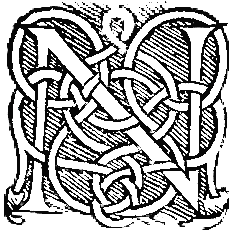 on ego iam cum huius vita, qua tætrius, miserius, detestabilius excogitare nihil possum, Platonis aut Archytæ vitam comparabo, doctorum hominum et plane sapientium: ex eadem urbe humilem homunculum a pulvere et radio excitabo, qui multis annis post fuit, Archimedem. Cuius ego quæstor ignoratum ab Syracusanis, cum esse omnino negarent, sæptum undique et vestitum vepribus et dumetis indagavi sepulcrum. Tenebam enim quosdam senariolos, quos in eius monumento esse inscriptos acceperam, qui declarabant in summo sepulcro sphæram esse positam cum cylindro. [65] Ego autem cum omnia conlustrarem oculis — est enim ad portas Agragantinas magna frequentia sepulcrorum -, animum adverti columellam non multum e dumis eminentem, in qua inerat sphæræ figura et cylindri. Atque ego statim Syracusanis — erant autem principes mecum—dixi me illud ipsum arbitrari esse, quod quærerem. Inmissi cum falcibus multi purgarunt et aperuerunt locum. [66] Quo cum patefactus esset aditus, ad adversam basim accessimus. Apparebat epigramma exesis posterioribus partibus versiculorum dimidiatum fere. Ita nobilissima Græciæ civitas, quondam vero etiam doctissima, sui civis unius acutissimi monumentum ignorasset, nisi ab homine Arpinate didicisset. Sed redeat, unde aberravit oratio: quis est omnium, qui modo cum Musis, id est cum humanitate et cum doctrina, habeat aliquod commercium, qui se non hunc mathematicum malit quam illum tyrannum? Si vitæ modum actionemque quærimus, alterius mens rationibus agitandis exquirendisque alebatur cum oblectatione sollertiæ, qui est unus suavissimus pastus animorum, alterius in cæde et iniuriis cum et diurno et nocturno metu. Age confer Democritum, Pythagoram, Anaxagoram: quæ regna, quas opes studiis eorum et delectationibus antepones?
on ego iam cum huius vita, qua tætrius, miserius, detestabilius excogitare nihil possum, Platonis aut Archytæ vitam comparabo, doctorum hominum et plane sapientium: ex eadem urbe humilem homunculum a pulvere et radio excitabo, qui multis annis post fuit, Archimedem. Cuius ego quæstor ignoratum ab Syracusanis, cum esse omnino negarent, sæptum undique et vestitum vepribus et dumetis indagavi sepulcrum. Tenebam enim quosdam senariolos, quos in eius monumento esse inscriptos acceperam, qui declarabant in summo sepulcro sphæram esse positam cum cylindro. [65] Ego autem cum omnia conlustrarem oculis — est enim ad portas Agragantinas magna frequentia sepulcrorum -, animum adverti columellam non multum e dumis eminentem, in qua inerat sphæræ figura et cylindri. Atque ego statim Syracusanis — erant autem principes mecum—dixi me illud ipsum arbitrari esse, quod quærerem. Inmissi cum falcibus multi purgarunt et aperuerunt locum. [66] Quo cum patefactus esset aditus, ad adversam basim accessimus. Apparebat epigramma exesis posterioribus partibus versiculorum dimidiatum fere. Ita nobilissima Græciæ civitas, quondam vero etiam doctissima, sui civis unius acutissimi monumentum ignorasset, nisi ab homine Arpinate didicisset. Sed redeat, unde aberravit oratio: quis est omnium, qui modo cum Musis, id est cum humanitate et cum doctrina, habeat aliquod commercium, qui se non hunc mathematicum malit quam illum tyrannum? Si vitæ modum actionemque quærimus, alterius mens rationibus agitandis exquirendisque alebatur cum oblectatione sollertiæ, qui est unus suavissimus pastus animorum, alterius in cæde et iniuriis cum et diurno et nocturno metu. Age confer Democritum, Pythagoram, Anaxagoram: quæ regna, quas opes studiis eorum et delectationibus antepones?
— Liber quintus, XXIII,64-66.
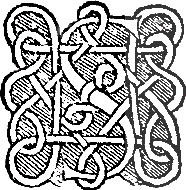 hall I not, then, prefer the life of Plato and Archytas, manifestly wise and learned men, to his, than which nothing can possibly be more horrid, or miserable, or detestable? I will present you with an humble and obscure mathematician of the same city, called Archimedes, who lived many years after; whose tomb, overgrown with shrubs and briers, I in my quæstorship discovered, when the Syracusans knew nothing of it, and even denied that there was any such thing remaining; for I remembered some verses, which I had been informed were engraved on his monument, and these set forth that on the top of the tomb there was placed a sphere with a cylinder. [65] When I had carefully examined all the monuments (for there are a great many tombs at the gate Achradinæ), I observed a small column standing out a little above the briers, with the figure of a sphere and a cylinder upon it; whereupon I immediately said to the Syracusans — for there were some of their principal men with me there — that I imagined that was what I was inquiring for. Several men, being sent in with scythes, cleared the way, and made an opening for us. [66] When we could get at it, and were come near to the front of the pedestal, I found the inscription, though the latter parts of all the verses were effaced almost half away. Thus one of the noblest cities of Greece, and one which at one time likewise had been very celebrated for learning, had known nothing of the monument of its greatest genius, if it had not been discovered to them by a native of Arpinum. But to return to the subject from which I have been digressing. Who is there in the least degree acquainted with the Muses, that is, with liberal knowledge, or that deals at all in learning, who would not choose to be this mathematician rather than that tyrant? If we look into their methods of living and their employments, we shall find the mind of the one strengthened and improved with tracing the deductions of reason, amused with his own ingenuity, which is the one most delicious food of the mind; the thoughts of the other engaged in continual murders and injuries, in constant fears by night and by day. Now imagine a Democritus, a Pythagoras, and an Anaxagoras; what kingdom, what riches, would you prefer to their studies and amusements?
hall I not, then, prefer the life of Plato and Archytas, manifestly wise and learned men, to his, than which nothing can possibly be more horrid, or miserable, or detestable? I will present you with an humble and obscure mathematician of the same city, called Archimedes, who lived many years after; whose tomb, overgrown with shrubs and briers, I in my quæstorship discovered, when the Syracusans knew nothing of it, and even denied that there was any such thing remaining; for I remembered some verses, which I had been informed were engraved on his monument, and these set forth that on the top of the tomb there was placed a sphere with a cylinder. [65] When I had carefully examined all the monuments (for there are a great many tombs at the gate Achradinæ), I observed a small column standing out a little above the briers, with the figure of a sphere and a cylinder upon it; whereupon I immediately said to the Syracusans — for there were some of their principal men with me there — that I imagined that was what I was inquiring for. Several men, being sent in with scythes, cleared the way, and made an opening for us. [66] When we could get at it, and were come near to the front of the pedestal, I found the inscription, though the latter parts of all the verses were effaced almost half away. Thus one of the noblest cities of Greece, and one which at one time likewise had been very celebrated for learning, had known nothing of the monument of its greatest genius, if it had not been discovered to them by a native of Arpinum. But to return to the subject from which I have been digressing. Who is there in the least degree acquainted with the Muses, that is, with liberal knowledge, or that deals at all in learning, who would not choose to be this mathematician rather than that tyrant? If we look into their methods of living and their employments, we shall find the mind of the one strengthened and improved with tracing the deductions of reason, amused with his own ingenuity, which is the one most delicious food of the mind; the thoughts of the other engaged in continual murders and injuries, in constant fears by night and by day. Now imagine a Democritus, a Pythagoras, and an Anaxagoras; what kingdom, what riches, would you prefer to their studies and amusements?
— Translated by Charles Duke Yonge, New York: Harper, 1877.
Archimedes
 rchimedes (c. 287-212 B.C.), Greek mathematician and inventor, was born at Syracuse, in Sicily. He was the son of Pheidias, an astronomer, and was on intimate terms with, if not related to, Hiero, king of Syracuse, and Gelo his son. He studied at Alexandria and doubtless met there Conon of Samos, whom he admired as a mathematician and cherished as a friend, and to whom he was in the habit of communicating his discoveries before publication. On his return to his native city he devoted himself to mathematical research. He himself set no value on the ingenious mechanical contrivances which made him famous, regarding them as beneath the dignity of pure science and even declining to leave any written record of them except in the case of the σφαιϱοποιία (Sphere-making), as to which see below. As, however, these machines impressed the popular imagination, they naturally figure largely in the traditions about him. Thus he devised for Hiero engines of war which almost terrified the Romans, and which protracted the siege of Syracuse for three years. There is a story that he constructed a burning mirror which set the Roman ships on fire when they were within a bowshot of the wall. This has been discredited because it is not mentioned by Polybius, Livy or Plutarch; but it is probable that Archimedes had constructed some such burning instrument, though the connexion of it with the destruction of the Roman fleet is more than doubtful. More important, as being doubtless connected with the discovery of the principle in hydrostatics which bears his name and the foundation by him of that whole science, is the story of Hiero’s reference to him of the question whether a crown made for him and purporting to be of gold, did not actually contain a proportion of silver. According to one story, Archimedes was puzzled till one day, as he was stepping into a bath and observed the water running over, it occurred to him that the excess of bulk occasioned by the introduction of alloy could be measured by putting the crown and an equal weight of gold separately into a vessel filled with water, and observing the difference of overflow. He was so overjoyed when this happy thought struck him that he ran home without his clothes, shouting ηὕϱηϰα, ηὕϱηϰα, “I have found it, I have found it.” Similarly his pioneer work in mechanics is illustrated by the story of his having said δῶς μοι πᾶ στῶ ϰαὶ τὰν γᾶν ϰινάσω (or as another version has it, in his dialect, Πᾷ βῶ, ϰαὶ χαϱιστίωνι τὰν γᾶν ϰινήσω πᾶσαν, “Give me a place to stand and I (will) move the earth.” Hiero asked him to give an illustration of his contention that a very great weight could be moved by a very small force. He is said to have fixed on a large and fully laden ship and to have used a mechanical device by which Hiero was enabled to move it by himself: but accounts differ as to the particular mechanical powers employed. The water-screw which he invented (see below) was probably devised in Egypt for the purpose of irrigating fields.
rchimedes (c. 287-212 B.C.), Greek mathematician and inventor, was born at Syracuse, in Sicily. He was the son of Pheidias, an astronomer, and was on intimate terms with, if not related to, Hiero, king of Syracuse, and Gelo his son. He studied at Alexandria and doubtless met there Conon of Samos, whom he admired as a mathematician and cherished as a friend, and to whom he was in the habit of communicating his discoveries before publication. On his return to his native city he devoted himself to mathematical research. He himself set no value on the ingenious mechanical contrivances which made him famous, regarding them as beneath the dignity of pure science and even declining to leave any written record of them except in the case of the σφαιϱοποιία (Sphere-making), as to which see below. As, however, these machines impressed the popular imagination, they naturally figure largely in the traditions about him. Thus he devised for Hiero engines of war which almost terrified the Romans, and which protracted the siege of Syracuse for three years. There is a story that he constructed a burning mirror which set the Roman ships on fire when they were within a bowshot of the wall. This has been discredited because it is not mentioned by Polybius, Livy or Plutarch; but it is probable that Archimedes had constructed some such burning instrument, though the connexion of it with the destruction of the Roman fleet is more than doubtful. More important, as being doubtless connected with the discovery of the principle in hydrostatics which bears his name and the foundation by him of that whole science, is the story of Hiero’s reference to him of the question whether a crown made for him and purporting to be of gold, did not actually contain a proportion of silver. According to one story, Archimedes was puzzled till one day, as he was stepping into a bath and observed the water running over, it occurred to him that the excess of bulk occasioned by the introduction of alloy could be measured by putting the crown and an equal weight of gold separately into a vessel filled with water, and observing the difference of overflow. He was so overjoyed when this happy thought struck him that he ran home without his clothes, shouting ηὕϱηϰα, ηὕϱηϰα, “I have found it, I have found it.” Similarly his pioneer work in mechanics is illustrated by the story of his having said δῶς μοι πᾶ στῶ ϰαὶ τὰν γᾶν ϰινάσω (or as another version has it, in his dialect, Πᾷ βῶ, ϰαὶ χαϱιστίωνι τὰν γᾶν ϰινήσω πᾶσαν, “Give me a place to stand and I (will) move the earth.” Hiero asked him to give an illustration of his contention that a very great weight could be moved by a very small force. He is said to have fixed on a large and fully laden ship and to have used a mechanical device by which Hiero was enabled to move it by himself: but accounts differ as to the particular mechanical powers employed. The water-screw which he invented (see below) was probably devised in Egypt for the purpose of irrigating fields.
Archimedes died at the capture of Syracuse by Marcellus, 212 B. C. In the general massacre which followed the fall of the city, Archimedes, while engaged in drawing a mathematical figure on the sand, was run through the body by a Roman soldier. No blame attaches to the Roman general, Marcellus, since he had given orders to his men to spare the house and person of the sage; and in the midst of his triumph he lamented the death of so illustrious a person, directed an honourable burial to be given him, and befriended his surviving relatives. In accordance with the expressed desire of the philosopher, his tomb was marked by the figure of a sphere inscribed in a cylinder, the discovery of the relation between the volumes of a sphere and its circumscribing cylinder being regarded by him as his most valuable achievement. When Cicero was quaestor in Sicily (75 B.C.), he found the tomb of Archimedes, near the Agrigentine gate, overgrown with thorns and briers. “Thus,” says Cicero (Tusc. Disp., v. c. 23, § 64), “would this most famous and once most learned city of Greece have remained a stranger to the tomb of one of its most ingenious citizens, had it not been discovered by a man of Arpinum.”
Works. — The range and importance of the scientific labours of Archimedes will be best understood from a brief account of those writings which have come down to us; and it need only be added that his greatest work was in geometry, where he so extended the method of exhaustion as originated by Eudoxus, and followed by Euclid, that it became in his hands, though purely geometrical in form, actually equivalent in several cases to integration, as expounded in the first chapters of our text-books on the integral calculus. This remark applies to the finding of the area of a parabolic segment (mechanical solution) and of a spiral, the surface and volume of a sphere and of a segment thereof, and the volume of any segments of the solids of revolution of the second degree.
The extant treatises are as follows: —
(1) On the Sphere and Cylinder (Πεϱὶ σφαίϱας ϰαὶ ϰυλίνδϱου). This treatise is in two books, dedicated to Dositheus, and deals with the dimensions of spheres, cones, "solid rhombi" and cylinders, all demonstrated in a strictly geometrical method. The first book contains forty-four propositions, and those in which the most important results are finally obtained are: 13 (surface of right cylinder), 14, 15 (surface of right cone), 33 (surface of sphere), 34 (volume of sphere and its relation to that of circumscribing cylinder), 42, 43 (surface of segment of sphere), 44 (volume of sector of sphere). The second book is in nine propositions, eight of which deal with segments of spheres and include the problems of cutting a given sphere by a plane so that (a) the surfaces, (b) the volumes, of the segments are in a given ratio (Props. 3, 4), and of constructing a segment of a sphere similar to one given segment and having (a) its volume, (b) its surface, equal to that of another (5, 6).
(2) The Measurement of the Circle (Κύϰλου μέτϱησις) is a short book of three propositions, the main result being obtained in Prop. 2, which shows that the circumference of a circle is less than 3-1/7 and greater than 3-10/71 times its diameter. Inscribing in and circumscribing about a circle two polygons, each of ninety-six sides, and assuming that the perimeter of the circle lay between those of the polygons, he obtained the limits he has assigned by sheer calculation, starting from two close approximations to the value of √3, which he assumes as known (265/153 < √3 < 1351/780).
(3) On Conoids and Spheroids (Πεϱὶ ϰωνοειδέων ϰαὶ σφαιϱοειδέων) is a treatise in thirty-two propositions, on the solids generated by the revolution of the conic sections about their axes, the main results being the comparisons of the volume of any segment cut off by a plane with that of a cone having the same base and axis (Props. 21, 22 for the paraboloid, 25, 26 for the hyperboloid, and 27-32 for the spheroid).
(4) On Spirals (Πεϱὶ ἑλίϰων) is a book of twenty-eight propositions. Propositions 1-11 are preliminary, 13-20 contain tangential properties of the curve now known as the spiral of Archimedes, and 21-28 show how to express the area included between any portion of the curve and the radii vectores to its extremities.
(5) On the Equilibrium of Planes or Centres of Gravity of Planes (Πεϱὶ ἐπιπέδων ἱσοϱϱοπιῶν ἤ ϰεντϱα βαϱῶν ἑπιπέδων). This consists of two books, and may be called the foundation of theoretical mechanics, for the previous contributions of Aristotle were comparatively vague and unscientific. In the first book there are fifteen propositions, with seven postulates; and demonstrations are given, much the same as those still employed, of the centres of gravity (1) of any two weights, (2) of any parallelogram, (3) of any triangle, (4) of any trapezium. The second book in ten propositions is devoted to the finding the centres of gravity (1) of a parabolic segment, (2) of the area included between any two parallel chords and the portions of the curve intercepted by them.
(6) The Quadrature of the Parabola (Τετϱαγωνισμὸς παϱαβολῆς) is a book in twenty-four propositions, containing two demonstrations that the area of any segment of a parabola is 4/3 of the triangle which has the same base as the segment and equal height. The first (a mechanical proof) begins, after some preliminary propositions on the parabola, in Prop. 6, ending with an integration in Prop. 16. The second (a geometrical proof) is expounded in Props. 17-24.
(7) On Floating Bodies (Πεϱὶ ὀχουμένων [Πεϱὶ τῶν ἐπιπλεόντων σωμάτων]) is a treatise in two books, the first of which establishes the general principles of hydrostatics, and the second discusses with the greatest completeness the positions of rest and stability of a right segment of a paraboloid of revolution floating in a fluid.
(8) The Psammites (Ψαμμίτης, Lat. Arenarius, or sand reckoner), a small treatise, addressed to Gelo, the eldest son of Hiero, expounding, as applied to reckoning the number of grains of sand that could be contained in a sphere of the size of our "universe," a system of naming large numbers according to "orders" and "periods" which would enable any number to be expressed up to that which we should write with 1 followed by 80,000 ciphers!
(9) A Collection of Lemmas, consisting of fifteen propositions in plane geometry. This has come down to us through a Latin version of an Arabic manuscript; it cannot, however, have been written by Archimedes in its present form, as his name is quoted in it more than once.
Lastly, Archimedes is credited with the famous Cattle-Problem, enunciated in the epigram edited by G. E. Lessing in 1773, which purports to have been sent by Archimedes to the mathematicians at Alexandria in a letter to Eratosthenes. Of lost works by Archimedes we can identify the following: (1) investigations on polyhedra mentioned by Pappus; (2) Ἁϱχαί, Principles, a book addressed to Zeuxippus and dealing with the naming of numbers on the system explained in the Sand Reckoner; (3) Πεϱὶ ζυγῶν, On balances or levers; (4) Κεντϱοβαϱιϰά, On centres of gravity; (5) Κατoπτϱiϰά, an optical work from which Theon of Alexandria quotes a remark about refraction; (6) Ἐφόδιον, a Method, mentioned by Suidas; (7) Πεϱὶ σφαιϱοπoιίας, On Sphere-making, in which Archimedes explained the construction of the sphere which he made to imitate the motions of the sun, the moon and the five planets in the heavens. Cicero actually saw this contrivance and describes it (De Rep. i. c. 14, §§ 21-22).
BIBLIOGRAPHY. — The editio princeps of the works of Archimedes, with the commentary of Eutocius, is that printed at Basel, in 1544, in Greek and Latin, by Hervagius. D. Rivault’s edition (Paris, 1615) gave the enunciations in Greek and the proofs in Latin somewhat retouched. A Latin version of them was published by Isaac Barrow in 1675 (London, 4to); Nicolas Tartaglia published in Latin the treatises on Centres of Gravity, on the Quadrature of the Parabola, on the Measurement of the Circle, and on Floating Bodies, i. (Venice, 1543); Trojanus Curtius published the two books on Floating Bodies in 1565 after Tartaglia’s death; Frederic Commandine edited the Aldine edition of 1558, 4to, which contains Circuli Dimensio, De Lineis Spiralibus, Quadratura Paraboles, De Conoidibus et Spheroidibus, and De numero Arenae; and in 1565 the same mathematician published the two books De iis quae vehuntur in aqua. J. Torelli’s monumental edition of the works with the commentaries of Eutocius, published at Oxford in 1792, folio, remained the best Greek text until the definitive text edited, with Eutocius’ commentaries, Latin translation, &c., by J. L. Heiberg (Leipzig, 1880-1881) superseded it. The Arenarius and Dimensio Circuli, with Eutocius’ commentary on the latter, were edited by Wallis with Latin translation and notes in 1678 (Oxford), and the Arenarius was also published in English by George Anderson (London, 1784), with useful notes and illustrations. The first modern translation of the works is the French edition published by F. Peyrard (Paris, 1808, 2 vols. 8vo.). A valuable German translation with notes, by E. Nizze, was published at Stralsund in 1824. There is a complete edition in modern notation by T. L. Heath (The Works of Archimedes, Cambridge, 1897). On Archimedes himself, see Plutarch’s Life of Marcellus. (T. L. H.)
— Encyclopædia Britannica Eleventh Edition, Volume 2. Cambridge: University Press, 1910. pp. 368-369. Written by Thomas Little Heath (1861-1940). Die griechischen Zitate wurden nach neueren Quellen korrigiert.
Federico Commandino
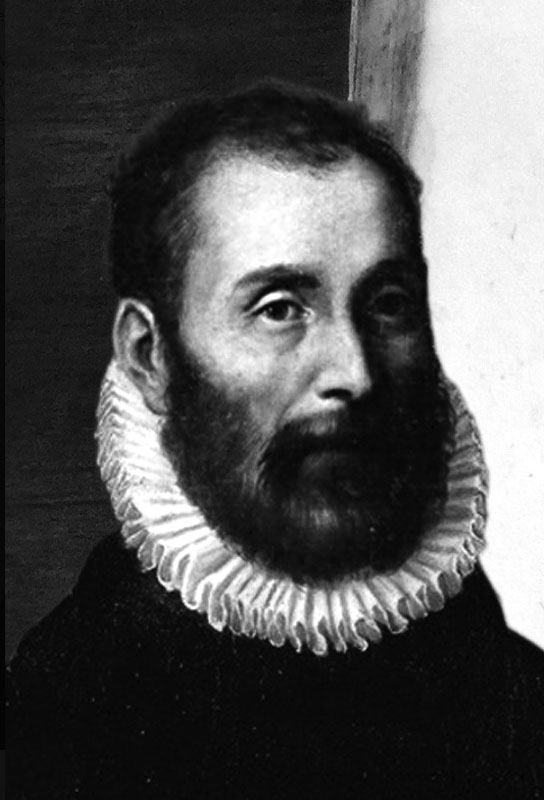
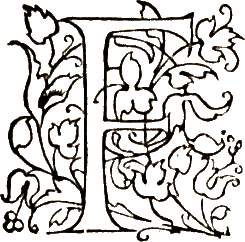 ederico Commandino (1509–September 3, 1575) was born and died in Urbino. His family, of noble origins, oriented the young man towards the study of humanities and sciences, continuing a family tradition strongly marked by a scholarly and masterful education. His humanistic education was therefore detailed and consolidated, with not only the study of Greek and Latin under the guidance of Giacomo Torelli da Fano (XVI possible to think that it consolidated this culture of identifying geometric and algebraic magnitudes. Similarly, it can be stated that, in the scientific and cultural development of mathematical thinking, Federico Commandino was one of the greatest European mathematicians-humanists of the sixteenth century, significantly influencing the history of science.
ederico Commandino (1509–September 3, 1575) was born and died in Urbino. His family, of noble origins, oriented the young man towards the study of humanities and sciences, continuing a family tradition strongly marked by a scholarly and masterful education. His humanistic education was therefore detailed and consolidated, with not only the study of Greek and Latin under the guidance of Giacomo Torelli da Fano (XVI possible to think that it consolidated this culture of identifying geometric and algebraic magnitudes. Similarly, it can be stated that, in the scientific and cultural development of mathematical thinking, Federico Commandino was one of the greatest European mathematicians-humanists of the sixteenth century, significantly influencing the history of science.
Specifically, in this scientific-mathematical retelling of classic (and late-medieval) works, Federico Commandino translated into Latin and/or Italian some of the writings of Archimede (287–212 B.C.), Euclide (III–II century B.C.), Pappo (320–? B.C.), Aristarco Samio (310–230 B.C.), Tolemeo (100–175), Giordano Nemorario (XIII century), Erone (I century?). Among his original scientific studies, there is the determination of the centre of gravity of a pyramid, the building in the perspective of a point and the circles of a sphere. In particular, the mathematical writings of Commandino on linear perspective laid the foundation for studies in an area that would be purely pictorial to a geometrician-mathematician.
— Ornella Zerlenga: Federico Commandino (1509–1575). pp. 126-127. In: Michela Cigola: Distinguished Figures in Descriptive Geometry and Its Applications for Mechanism Science. From the Middle Ages to the 17th Century. Heidelberg etc.: Springer, 2016.
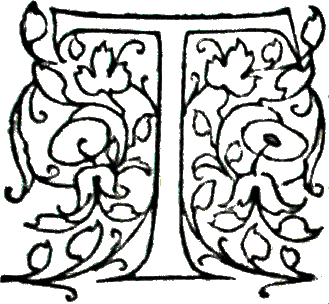 he little that is known about Commandino’s life is derived mainly from a brief biography written by a younger fellow townsman who knew him well for many years toward the end of his career.
he little that is known about Commandino’s life is derived mainly from a brief biography written by a younger fellow townsman who knew him well for many years toward the end of his career.
Descended from a noble family of Urbino, Commandino studied Latin and Greek for some years with a humanist at Fano. When Rome was sacked on 6 May 1527 by the army of Charles V, the Orsini, a leading noble clan, fled to Urbino. For one of their sons they procured a tutor proficient in mathematics, who also taught Commandino. After this tutor became a bishop on 6 June 1533, he obtained for Commandino an appointment as private secretary to Pope Clement VII. However, the pontiff died on 25 September 1534, and Commandino went to the University of Padua. There he studied philosophy and medicine for ten years, but he took his medical degree from the University of Ferrara.
Returning to his birthplace, Commandino married a local noblewoman, who died after giving birth to two daughters and a son. Commandino resolved not to marry a second time. After his son’s death he put the girls in a convent school (and later found husbands for them). Withdrawing from the general practice of medicine, he turned to his true vocation: editing, translating, and commenting on the classics of ancient Greek mathematics. Gaining renown thereby, Commandino was designated the private tutor and medical adviser to the duke of Urbino. The duke, however, was married to the sister of a cardinal; and the latter persuaded Commandino to be his personal physician in his intellectually stimulating household in Rome.
Commandino had been translating into Latin and commenting on Archimedes’ Measurement of the Circle (with Eutocius’ commentary), Spirals, Quadrature of the Parabola, Conoids and Spheroids, and Sand-Reckoner. Besides the first printed edition of the Greek text of these five works and an earlier Latin translation of them (Basel, 1544), he had access also to a Greek manuscript in Venice, where his patron was residing when Commandino published this Archimedes volume in 1558.
During the previous year Commandino had heard complaints about the difficulty of understanding Ptolemy’s Planisphere, which showed how circles on the celestial sphere may be stereographically projected onto the plane of the equator. Although the Greek text of the Planisphere is lost, it had been translated into Arabic, and from Arabic into Latin. This Latin version, done at Toulouse in 1144, and Jordanus de Nemore’s Planisphere, both of which had been printed at Basel in 1536, were edited by Commandino and, together with his commentary on Ptolemy’s Planisphere, were published at Venice in 1558.
Ptolemy’s Analemma explained how to determine the position of the sun at a given moment in any latitude by an orthogonal projection using three mutually perpendicular planes. Again, as in the case of Ptolemy’s Planisphere, no Greek text was available to Commandino (a portion was later recovered from a palimpsest); but an Arabic version had been translated into Latin. This was edited from the manuscript by Commandino (Rome, 1562). Besides his customary commentary, he added his own essay On the Calibration of Sundials of various types, since he felt that Ptolemy’s discussion was theoretical rather than practical.
Commandino’s only other original work, dealing with the center of gravity of solid bodies, was published in 1565 at Bologna, of which his patron had become bishop on 17 July of the preceding year. Commandino’s interest in this topic was aroused by Archimedes’ Floating Bodies, of which he had no Greek text, unlike the five other Archimedean works he had previously translated. Since his time a large part of the Greek text of Floating Bodies has been recovered, but he had only a printed Latin translation (Venice, 1543, 1565), which he commented on and corrected (Bologna, 1565). In particular the proof of proposition 2 in book II was incomplete, and Commandino filled it out. One step required knowing the location of the center of gravity of any segment of a parabolic conoid. No ancient treatment of such a problem was then known, and Commandino’s was the first modern attempt to fill the existing gap.
Archimedes’ Floating Bodies assumed the truth of some propositions for which Commandino searched in Apollonius’ Conics. Of the Conics’ eight books only the first four are extant in Greek, and he had access to them in manuscript. An earlier Latin translation (Venice, 1537) was superseded by his own (Bologna, 1566), to which he added Eutocius’ commentary, the relevant discussion in Pappus’ Collection (book VII), the first complete Latin translation (from a Greek manuscript) of Serenus’ Section of a Cylinder and Section of a Cone, and his own commentary.
Overwork and the death of his patron on 28 October 1565 greatly depressed Commandino; and he returned to Urbino, where he could live quietly, for many months on a salt-free diet. He resumed his former activities, however, after being visited by John Dee, who gave him a manuscript Latin translation of an Arabic work related to Euclid’s On Divisions (of figures), of which the Greek original is lost. Commandino published this Latin translation and added a short treatise of his own to condense and generalize the discussion in the manuscript (Pesaro, 1570).
At the request of his ruler’s son, Commandino translated Euclid’s Elements into Latin and commented on it extensively (Pesaro, 1572). Also in 1572 he published at Pesaro his Latin translation of and commentary on Aristarchus’ Sizes and Distances of the Sun and Moon, with Pappus’ explanations (Collection, book VI, propositions 37–40).
For those of his countrymen who did not know Latin, Commandino supervised a translation of Euclid’s Elements into Italian by some of his students (Urbino, 1575). His own Latin translation of Hero’s Pneumatics (Urbino, 1575) was seen through the press by his son-in-law immediately after his death. From a nearly complete manuscript, needing three months’ work at most, his faithful pupil Guidobaldo del Monte published Commandino’s Latin translation of and commentary on Pappus’ Collection, books III-VIII (Pesaro, 1588).
In the sixteenth century, Western mathematics emerged swiftly from a millennial decline. This rapid ascent was assisted by Apollonius, Archimedes, Aristarchus, Euclid, Eutocius, Hero, Pappus, Ptolemy, and Serenus — as published by Commandino.
Bibliography
A list of Commandino’s publications is available in Pietro Riccardi, Biblioteca matematica italiana, enl, ed., 2 vols, (Milan, 1952) I. cols, 42 359–365; II, pt, 1 col, 15; II pt. 2 col. 117. II pt, 5 cols. 9, 49–50; II, pt, 6 col. 189; II pt, 7 cols. 25–26. Riccardi omits Conoids and Spheroids (I, col. 42); misattributes the Italian translation of Euclid’s Elements to Commandino himself (I, col. 364): and misdates Pappus’ Collection as 1558 (correct date, 1588; II, pt. I, col. 15). To Riccardi’s list of writings about Commandino (I, col. 359; II, pt. 1, col. 15) add Edward Rosen, “The Invention of the Reduction Compass,” in Physis, 10 (1968), 306–308; and “John Dee and Commandino,” in Scripta mathematica, 28 (1970), 321–326.
Bernardino Baldi’s biography of Commandino, completed on 22 November 1587, was first published in Giornal de’ letterati d’Italia, 19 (1714), 140–185, and reprinted in Versi e prose scelte di Bernardino Baldi, F. Ugolino and F.-L. Polidori, eds. (Florence, 1859), pp. 513–537.
— Edward Rosen. In: Encyclopedia.com.
Deutsche Übersetzungen
Archimedes:
Werke. Übersetzt und mit Anmerkungen versehen von Arthur Czwalina. Im Anhang: Kreismessung. Übersetzt von F. Rudio. Des Archimedes Methodenlehre von den mechanischen Lehrsätzen. Übersetzt von J. L. Heiberg und kommentiert von H. G. Zeuthen.
Darmstadt: Wissenschaftliche Buchgesellschaft, 1972.
Ein Nachdruck von Übersetzungen der 20er Jahre.
